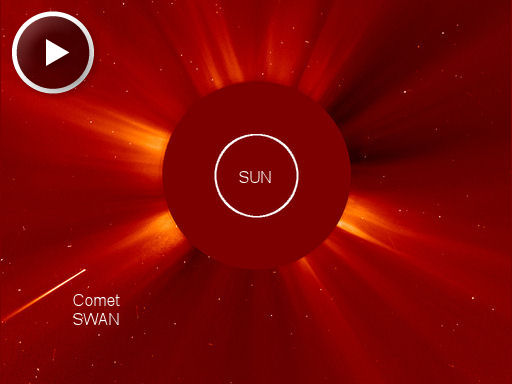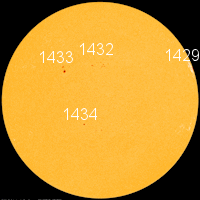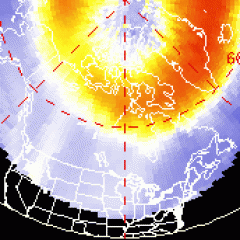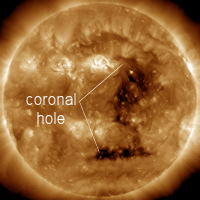~Space Weather Update~ CME Impact Wind Speed cooking at 742~ [1]
CME IMPACT: As expected, the flank of a CME hit Earth's magetic field today, March 15th, around 1300 UT. A high-latitude geomagnetic storm might be in the offing. Stay tuned. Storm alerts: text [2], phone [3].
COMET, DELETED: Sungrazing Comet SWAN, which dove into the sun's atmosphere during the late hours of March 14th, apparently did not survive. In the following 10 hour movie, Comet SWAN enters the solar corona but does not exit again:
Comet SWAN was a Kreutz sungrazer [5], a fragment of the same ancient comet that produced sungrazing Comet Lovejoy in Dec. 2011. Comet Lovejoy famously survived [6] its brush with the sun and put on a flamboyant show [7] after it emerged from the solar fire. While Comet SWAN was cut from the same cloth, it was a smaller fragment that has completely evaporated.
The CME emerging from the sun's northwestern limb near the end of the movie was not caused by this tiny comet's impact. It is just another eruption of active sunspot 1429.
Stay tuned to comet expert Karl Battam's blog [8] for updates.
SUNSET CONJUNCTION: When the sun goes down tonight, step outside and look west. Venus and Jupiter are beaming through the twilight less than 4o apart. Sky watchers of all ages, and species, are enjoying the show:
"I was out last night walking the dogs," explains photographer Robert Hanelt of Santa Fe, New Mexico. "We just had to stop to admire the planets."
Observing tip: Try to catch the duo before the sky fades completely black. Venus and Jupiter surrounded by twilight blue is a barking-good sight.
more images: from Peter Detterline [10] of Douglassville, PA; from Aleksandar Gospić [11] of Zadar, Croatia; from Geoff Chester [12] of Alexandria, Virginia; from Stanislaw Rokita [13] of Torun, Poland; from Andreas Walker [14] of Altenrhein, Switzerland; from Sue Stefanowicz [15] of Oregon, IL; from Manfred Birawsky [16] of Krefeld, Germany; from Marco Meniero [17] of Pisa, Toscany, Italy; from Alan Dyer [18] of near Calgary, Alberta, Canada; from Mike O'Leary [19] of El Cajon, CA; from De Martin [20] of Bagley, Wisconsin; from Bev Teter [21] of Falkville, AL; from Gustavo Rojas [22] of São Carlos, SP, Brasil

![]()
Solar wind
speed: 742.2 km/sec
density: 4.5 protons/cm3
explanation [23] | more data [24]
Updated: Today at 1435 UT
![]()
X-ray Solar Flares
6-hr max: M1 0752 UT Mar15
24-hr: M1 0752 UT Mar15
explanation [25] | more data [26]
Updated: Today at: 1400 UT
![]()
![]()
![]()
Daily Sun: 15 Mar 12
![]()
![]()
Active sunspot AR1429 is turning away from Earth. Credit: SDO/HMI
![]()
![]()
![]()
Sunspot number: 75
What is the sunspot number? [28]
Updated 14 Mar 2012
Spotless Days
Current Stretch: 0 days
2012 total: 0 days (0%)
2011 total: 2 days (<1%)
2010 total: 51 days (14%)
2009 total: 260 days (71%)
Since 2004: 821 days
Typical Solar Min: 486 days
Updated 14 Mar 2012
The Radio Sun
10.7 cm flux: 119 sfu
explanation [29] | more data [30]
Updated 14 Mar 2012
![]()
![]()
![]()
Current Auroral Oval:
![]()
Switch to: Europe, USA, New Zealand, Antarctica
Credit: NOAA/POES
![]()
![]()
![]()
Planetary K-index
Now: Kp= 2 quiet
24-hr max: Kp= 3 quiet
explanation [32] | more data [33]
![]()
Interplanetary Mag. Field
Btotal: 9.6 nT
Bz: 9.1 nT south
explanation [34] | more data [35]
Updated: Today at 1437 UT
![]()
![]()
![]()
Coronal Holes: 15 Mar 12
![]()
![]()
A solar wind stream flowing from this coronal hole could reach Earth on March 17-18. Credit: SDO/AIA.
Category:
- Ground Crew Updates [37]




